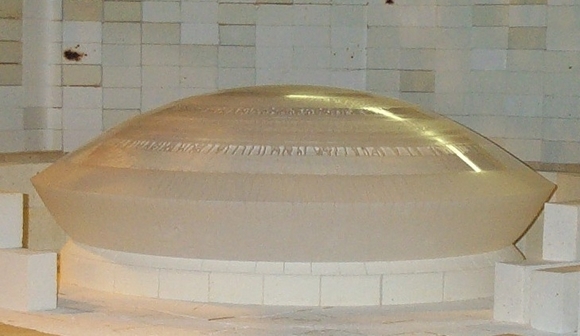Discovering the universe is accelerating and not slowing down made it obvious to astronomers there's a lot we don't know about the universe; namely, a big chunk of it is missing from our visible observations. Astronomers determined roughly 4% of the universe is made up of ordinary matter and 27% of Dark Matter (inferred from gravitational affects on visible matter), leaving 68% unaccounted for. Dark energy, while still hypothetical, is what is believed to keep the pedal to the metal, so to speak, on the universe's expansion. But an international group of astronomers believes that dark energy should be detectable, and they are constructing a huge camera, designed to look for it. The camera will consist of five massive lenses, with the largest at one meter in diameter, making it one of the biggest lenses in the world. A milestone was reached in the construction of this camera, as the pieces of glass for these unique lenses, seen in the image here, are ready to be shaped and polished into their final form.
The Dark Energy Survey (DES) camera will map 300 million galaxies using the Blanco 4-meter telescope - a large telescope with new advanced optics at Chile's Cerro Tololo Inter-American Observatory. This instrument will consist of an extremely red sensitive 500 Megapixel camera, with a 1 meter diameter, 2.2 degree field of view prime focus corrector, and a data acquisition system fast enough to take images in 17 seconds.
Creating this huge map of the galaxy will enable astronomers to measure the dark energy far more precisely than current observations. Professor Ofer Lahav, who leads the United Kingdom DES Consortium said, "Dark Energy is one of the biggest puzzles in the whole of Physics, going back to a concept proposed by Einstein 90 years ago. The DES observations will tell us if Einstein was right or if we need a major shift in our understanding of the universe."
The glass for the five lenses was manufactured in the US. In France the lenses will be polished to a smoothness level of one millionth of a centimeter.
After, polishing, the lenses will be sent to the telescope in Chile. Observations are scheduled to begin in 2011, continuing until 2016.
The team's goals are to extract cosmological information on dark energy from counting galaxy clusters and the spatial distribution of clusters, and measuring the redshift of galaxies and supernovae.
The Science and Technology Facilities Council (STFC) is providing support for the Dark Energy Survey (DES) collaboration, which involves over 100 scientists from the US, UK, Spain and Brazil.
Orignal news sources: Science and Technology Facilities Council,
Dark Energy Survey
 Universe Today
Universe Today
